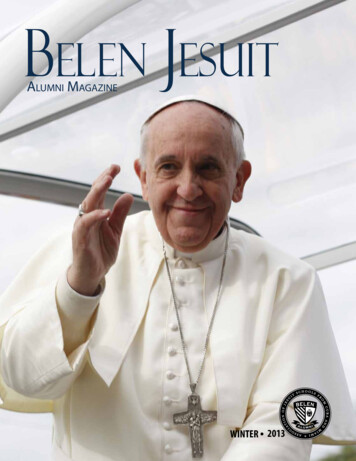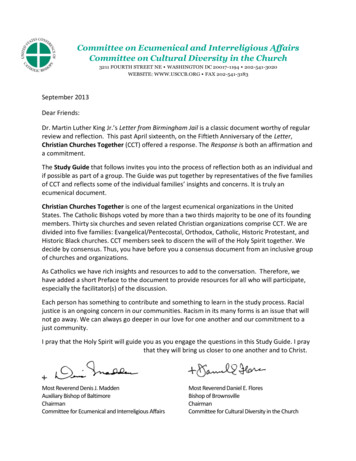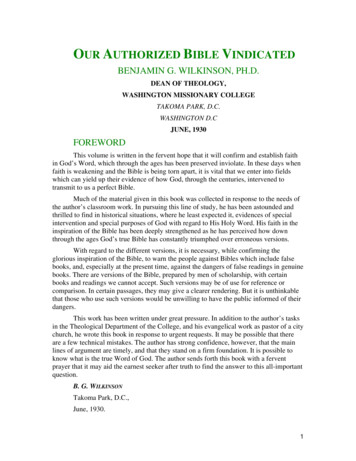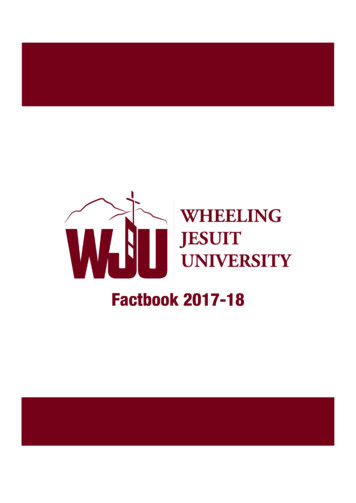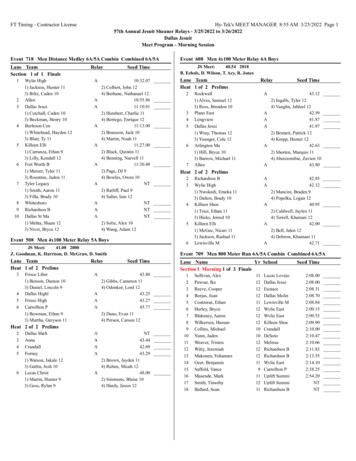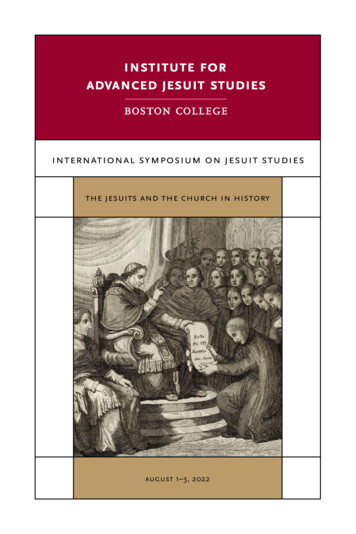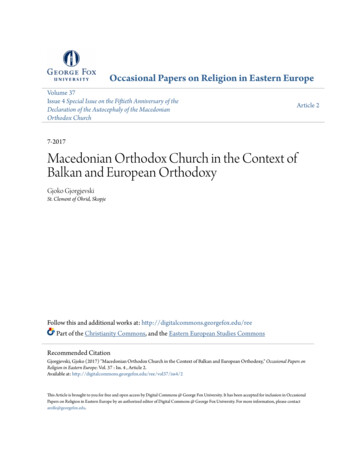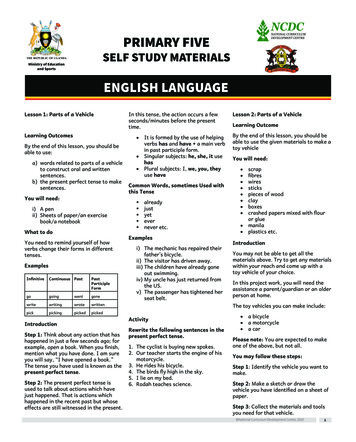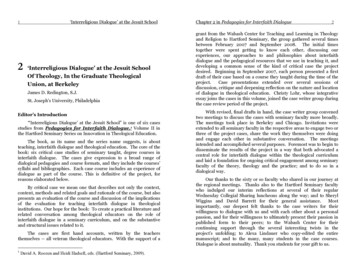
Transcription
‘Interreligious Dialogue’ at the Jesuit School12‘Interreligious Dialogue’ at the Jesuit SchoolOf Theology, In the Graduate TheologicalUnion, at BerkeleyJames D. Redington, S.J.St. Joseph’s University, PhiladelphiaEditor’s Introduction“‘Interreligious Dialogue’ at the Jesuit School” is one of six casesstudies from Pedagogies for Interfaith Dialogue,1 Volume II inthe Hartford Seminary Series on Innovation in Theological Education.The book, as its name and the series name suggests, is aboutteaching, interfaith dialogue and theological education. The core of thebook: six critical case studies of seminary taught, degree courses ininterfaith dialogue. The cases give expression to a broad range ofdialogical pedagogies and course formats, and they include the courses’syllabi and bibliographies. Each case course includes an experience ofdialogue as part of the course. This is definitive of the project, forreasons elaborated below.By critical case we mean one that describes not only the context,content, methods and related goals and rationale of the course, but alsopresents an evaluation of the course and discussion of the implicationsof the evaluation for teaching interfaith dialogue in theologicalinstitutions. Our hope for the book: To create a practical literature andrelated conversation among theological educators on the role ofinterfaith dialogue in a seminary curriculum, and on the substantiveand structural issues related to it.The cases are first hand accounts, written by the teachersthemselves -- all veteran theological educators. With the support of a1David A. Roozen and Heidi Hadsell, eds. (Hartford Seminary, 2009).Chapter 2 in Pedagogies for Interfaith Dialogue2grant from the Wabash Center for Teaching and Learning in Theologyand Religion to Hartford Seminary, the group gathered several timesbetween February 2007 and September 2008. The initial timestogether were spent getting to know each other, discussing ourexperiences, our approaches to and philosophies about interfaithdialogue and the pedagogical resources that we use in teaching it, anddeveloping a common sense of the kind of critical case the projectdesired. Beginning in September 2007, each person presented a firstdraft of their case based on a course they taught during the time of theproject.Case presentations extended over several sessions ofdiscussion, critique and deepening reflection on the nature and locationof dialogue in theological education. Christy Lohr, whose integrativeessay joins the cases in this volume, joined the case writer group duringthe case review period of the project.With revised, final drafts in hand, the case writer group convenedtwo meetings to discuss the cases with seminary faculty more broadly.The meetings took place in Berkeley and Chicago. Invitations wereextended to all seminary faculty in the respective areas to engage two orthree of the project cases, share the work they themselves were doingand engage each other in substantive conversation. The meetingsintended and accomplished several purposes. Foremost was to begin todisseminate the results of the project in a way that both advocated acentral role for interfaith dialogue within the theological curriculumand laid a foundation for ongoing critical engagement among seminaryfaculty of the theory, theology and the practice; and to do so in adialogical way.Our thanks to the sixty or so faculty who shared in our journey atthe regional meetings. Thanks also to the Hartford Seminary facultywho indulged our interim reflections at several of their regularWednesday Collegial Sharing luncheons along the way; and to SherylWiggins and David Barrett for their general assistance.Mostimportantly, our deepest felt thanks to the case writers for theirwillingness to dialogue with us and with each other about a personalpassion, and for their willingness to ultimately present their passion inpublished form to their peers; to the Wabash Center for theircontinuing support through the several interesting twists in theproject’s unfolding; to Alexa Lindauer who copy-edited the entiremanuscript; and to the many, many students in the case courses.Dialogue is about mutuality. Thank you students for your gift to us.
3‘Interreligious Dialogue’ at the Jesuit SchoolWhy this Book at this TimeSeptember 11, 2001 got America’s attention. Tragic – in so manyways. Earth shattering – in so many ways. World changing – in somany ways. Among the latter, as one of us shared at the annualmeeting of the Religion News Writers Association less than two weekslater, the shift from an Ecumenical to Interfaith Consciousness aboutAmerica’s Religious Diversity.Critical to the point is that this shift is about awareness andacknowledgement, not a sudden change in presence or numbers.Muslims have been in North America since the beginning of our historywith slavery, and adherents of Islam and a variety of Asian religionshave been increasing steadily since changes to immigration laws nearly50 years ago. The relative lack of acknowledgement of the multi-faithreality in the United States prior to September 11 is suggested, forexample, by the fact that a major survey of congregations in the U.S.conducted in 2000 found that while 45% of congregations wereinvolvement in ecumenical Christian worship in the year prior to thesurvey, only 7% indicated involvement in interfaith worship (and muchof this was Christian/Jewish).The multi-faith character of American society would be, of course,no surprise to theological educators.Indeed, in an essay on“Globalization, World Religions and Theological Education” in the“Looking Toward the Future” section of the 1999 volume of TheologicalEducation celebrating the conclusion of Association of TheologicalEducation’s decade of globalization (Vol 35, No 2, pp 143-153), M.Thangaraj explicitly recognizes that, “Dialogue across religiousboundaries has become a daily activity in many people’s lives.” Hisconclusion and plead: an increased engagement with world religions iscritical for Christian theological education for three reasons. AChristian minister cannot have an adequate theological grounding forhis or her faith without a meaningful understanding of how it relates toother faith traditions. A minister cannot adequately address theeveryday interfaith experience and practice of his or her laity. Publicministry in today’s world is increasingly interfaith.World and national events since September 2001 have onlyintensified awareness of Muslims and Islam in particular and multifaith diversity more broadly in the United States. Public opinion pollssuggest both encouraging and discouraging developments. Americanattitudes toward American Muslims are a bit more positive today thanChapter 2 in Pedagogies for Interfaith Dialogue4nine years ago and American congregations’ involvement in interfaithworship has more than doubled since the 2000. In contrast, Americanattitudes toward Islam as a religion are less positive today and thedominant approaches of congregations to interfaith issues appear toremain indifference and avoidance.Against this background of increasing awareness, increasednecessity (assuming tolerance across diversity is a good thing), andincreased lay and congregational involvement in interfaith engagement,one might think that a subject like Interfaith Dialogue (as a vehicle fortolerance through enhanced understanding and connection) would be ahot-bed of interest in theological education, or at least a begrudgingcapitulation to reality. The evidence is, unfortunately, less compelling.For example, one will not find a single article in Theological Educationabout interfaith dialogue between September 2001 and January 2007,when the case authors in this volume first met; indeed, not since theconclusion of the ATS decade of globalization in 1999; and in fact, notsince the journal’s inception in 1964! Nor have there been any to date(through Vol 44, No 2, 2009). This is all the more ironic given thecentrality of “diversity” to ATS priorities and, relatedly, to issues ofTheological Education. Tellingly, the one article in TheologicalEducation that contains “Dialogue” in its title is about black and latinotheologies (Vol 38, No 2, 2002, p 87-109).A survey of seminary deans and an online search of seminarycatalogues done in fall, 2006 to help identify possible seminary coursesfor this book was only a little more dialogically-friendly thanTheological Education. The good news is that we were able to findseveral courses that fit our criteria. The bad news was that there wereonly a few more than the five seminaries represented in the book thatoffered degree courses taught by regular faculty that included anexperience of interfaith dialogue.This certainly fit our impressions. As we looked out acrosstheological education in the United States we found that although thereseemed to be a lot of talk about and enthusiasm for interfaith dialogue,there was a paucity of courses related to interfaith dialogue in even thebroadest sense, and very few places in which interfaith dialogue wasactually happening. There was, from our vantage point, a curricularand pedagogical vacuum that badly needed to be filled.More encouraging, at first glance, was our discovery of anentire section of syllabi listed under Interreligious Dialogue on the
‘Interreligious Dialogue’ at the Jesuit School5Wabash Center Guide to Internet Resources For Teaching and Learningin Theology and Religion. Unfortunately, a quick perusal in June 2007indicated that an actual conversation or encounter with a person ofanother faith tradition was not a goal of a single course listed; and thatlearning about the practice of putting persons from different faithtraditions into conversation or dialogue with each other was a goal of,at most, one of the courses. Among other things this means that fromamong the half dozen or so different types of interreligious dialoguetypical of the emerging literature on the subject, the cutting edge ofuniversity and seminary courses on dialogue listed on the Wabash siteall narrowly focused on a single, and typically the most rudimentary,purpose. In terms of the following list of types of dialogue, for example,the Wabash site syllabi all fall into “Informational,” although severalmove beyond basic comparative religions to also include the history ofrelations between two or more faith tradition.1)Informational: Acquiring of knowledge of the faith partner'sreligious history, founding, basic beliefs, scriptures, etc.2) Confessional: Allowing the faith partners to speak for anddefine themselves in terms of what it means to live as anadherent.3) Experiential: Dialogue with faith partners from within thepartner's tradition, worship and ritual - entering into thefeelings of one's partner and permitting that person's symbolsand stories to guide.4) Relational: Develop friendships with individual personsbeyond the "business" of dialogue.5) Practical: Collaborate to promote peace and justice.[http://www.scarboromissions.ca/Interfaith dialogue/guidelines interfaith.php#goals]Such narrow and elementary approaches, we believe, cannotadequately address the three reasons set forth by Thangaraj almost adecade ago for why the increased engagement of interfaith issues iscritical for theological education. Rather, we believe, theologicaleducation can only meet these challenges for its ministry students andrelated congregations and denominations by exposing students to thefull range of dialogical purposes. Hence, our desire for the book tocreate a practical literature and related conversation among theologicalChapter 2 in Pedagogies for Interfaith Dialogue6educators on the role of the practice of interfaith dialogue in a seminarycurriculum is driven by the related desire to be a constructive advocatefor courses in Interfaith Dialogue using pedagogies that optimize thefull range of dialogical purposes and practices. To use ATS outcomelanguage: we want to enhance the capacity of seminaries to equip theirs
A survey of seminary deans and an online search of seminary catalogues done in fall, 2006 to help identify possible seminary courses for this book was only a little more dialogically-friendly than Theological Education. The good news is that we were able to find several courses that fit our criteria. The bad news was that there were


